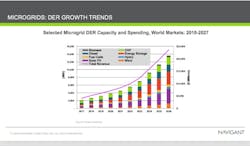How important to the growth of the microgrid industry are storms and disasters? That was one of the questions panelists addressed at Microgrid 2018, a conference that drew about 400 participants to Chicago.
The panelists also identified cost as a barrier to growth, but some offered innovative solutions to cost challenges. Another presentation about Australia focused on some of the conditions that make an area ripe for microgrid development.
During the panel, “Phoenix Rising: Out of the Disasters of 2017, a New Wave of Microgrid Development. Where, When, How?” moderator Ken Horne, director of Navigant’s Global Energy Practice, asked audience members if we’d see an increase in the numbers of microgrids as a result of this year’s storms. Seventy-five percent said yes. But audience members also said that the microgrids wouldn’t be built within a year. And they said that as memories of storms recede, microgrids become less important to potential users.
“The industry is built on the burning platform of the day,” said Mike Carlson, president, Siemens Digital Grid North America. “What are the value perceptions?”
He noted that residential customers hate to be without power but generally don’t lose much except the food that spoils in the freezers. Businesses lose more as a result of power outages.
“The industry is built on the burning platform of the day” — Michael Carlson, Siemens
“Are we going to expand the problem to look at all these things combined, not just my value proposition?” he said.
Michael Bakas, executive vice president, distributed energy systems of Ameresco, noted that Delta’s outage in Atlanta spurred some interest in microgrids. “We are seeing other airports interested,” he said.
Said Thomas McAndrew, president and CEO of Enchanted Rock, about interest in microgrids, “It’s a function of the perception of the repeatability of the event.”
When Horne asked the audience to identify the biggest source of risk to resiliency microgrid project development success, the most popular answer from audience members was cash-flow generation.
McAndrew said that his customers say they want access to microgrid revenues, but if they’re told to take on some risk, they say they’ll forgo risk and just take the resiliency benefits.
He also said that for his company, a big risk is the utility costs of synchronous interconnection.
“It can cost from free to $1 million per megawatt,” he said.
During a different event, “Growing Microgrid Markets by Reducing Risk for Customers,” Elisa Wood, Microgrid Knowledge editor-in-chief, interviewed three companies that have formed a partnership to provide innovative financing options for customers as part of an overall “energy-as-a-service” model.
The panel was made up of Mark Feasal, vice president, utility and smart grids, Schneider Electric; Andrew Marino, managing director, The Carlyle Group; and Karen Morgan, CEO, Dynamic Energy Networks.
“We believe electricity is a basic human right. We have to bring more on the grid but have to use it more efficiently,” said Feasal.
“We believe electricity is a basic human right.” — Mark Feasel, Schneider
All three participants stressed that the goal of the partnership is to help potential microgrid users reduce risk by listening to their needs and trying to develop financing solutions that are unique to those needs — instead of offering pre-packaged financing options.
“It’s the right solution for consumers if they can quantify what it means to them,” said Feasal. “A company that determines what’s important can see how energy-as-a service can be part of that.”
Marino said that his company, the Carlyle Group, manages pension fund money and invests it in alternative assets to achieve better returns to help people retire. He’s focused on microgrids because he believes it’s a big market and offered airports, utilities and municipalities as example of growing markets.
“We don’t focus on buying assets but using our capital to deliver outcomes that deliver cleaner power, more transparent sources of energy, and greater resilience,” he said.
Morgan said that one of her goals in offering innovative financing is to eliminate the option of using lack of financing as an excuse for not pursuing projects — in short, she is in the “excuse removal business.”
During a presentation, “Global Microgrid Tour: All Signs Point to Australia,” Peter Asmus, principal research analyst, Navigant, described innovative microgrid projects in Australia, focusing on the work of Horizon Power, whose service territory is as large as five states the size of California. He noted that Australia has one of the highest energy consumption rates per capita in the world, partly because people live in remote areas and use air conditioning. Australia also has the highest rooftop solar penetration in the world. These factors combine to spur innovation, he said.
“It’s emerging as a leading market,” he said.
During Asmus’s talk, Craig Wooster, project manager for the Stone Edge Farm microgrid — which continued producing power while wildfires knocked out power all around the farm — brought the focus back to the issue of the effect of natural disasters on the microgrid market.
“Once you live through one of these events you will think of resiliency in a new light,” he said.
Track news about the growing microgrid industry. Subscribe to the free Microgrid Knowledge newsletter.








